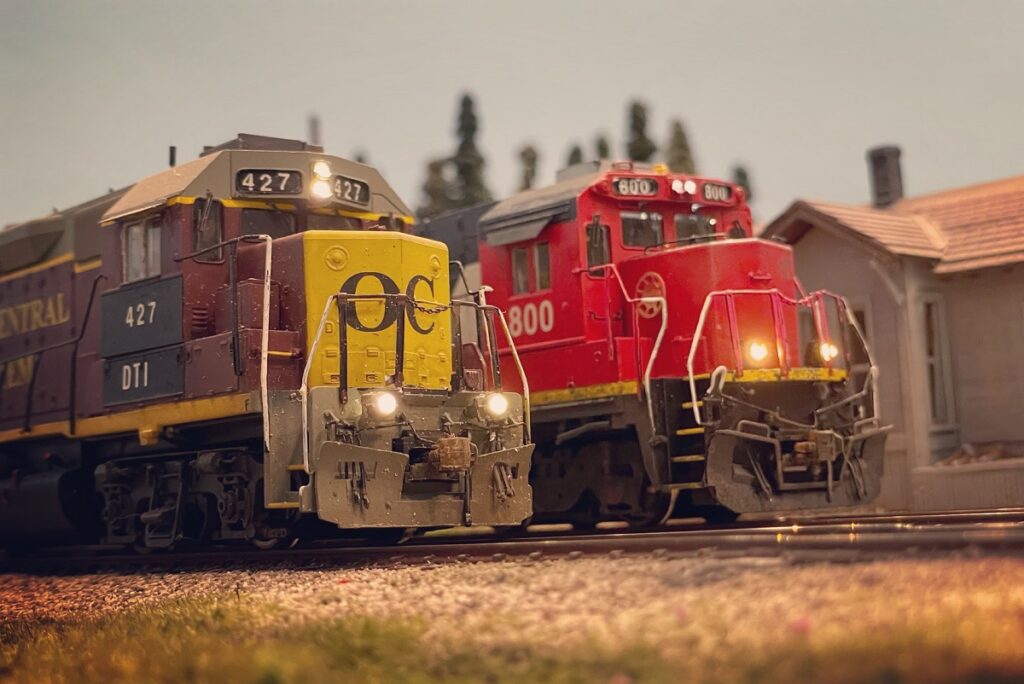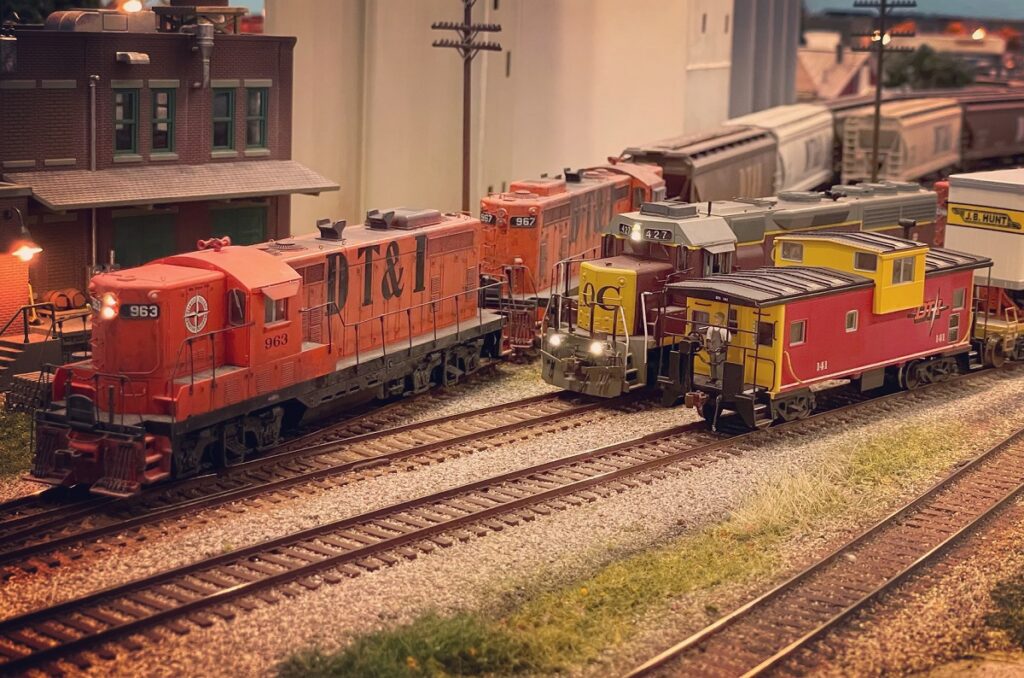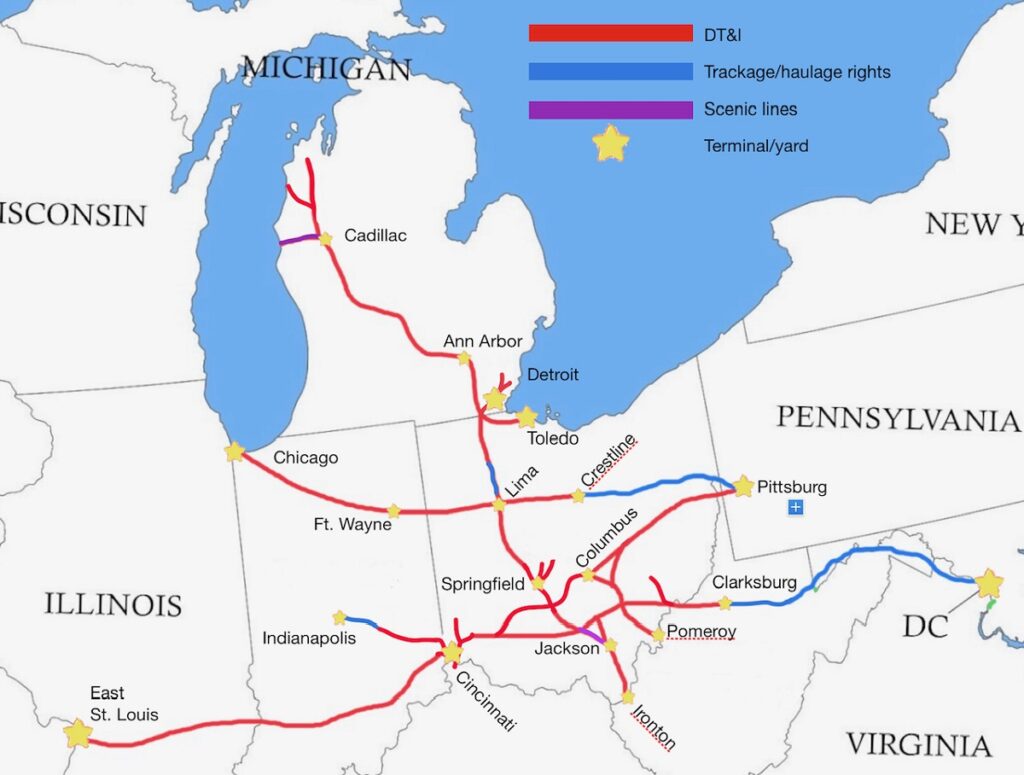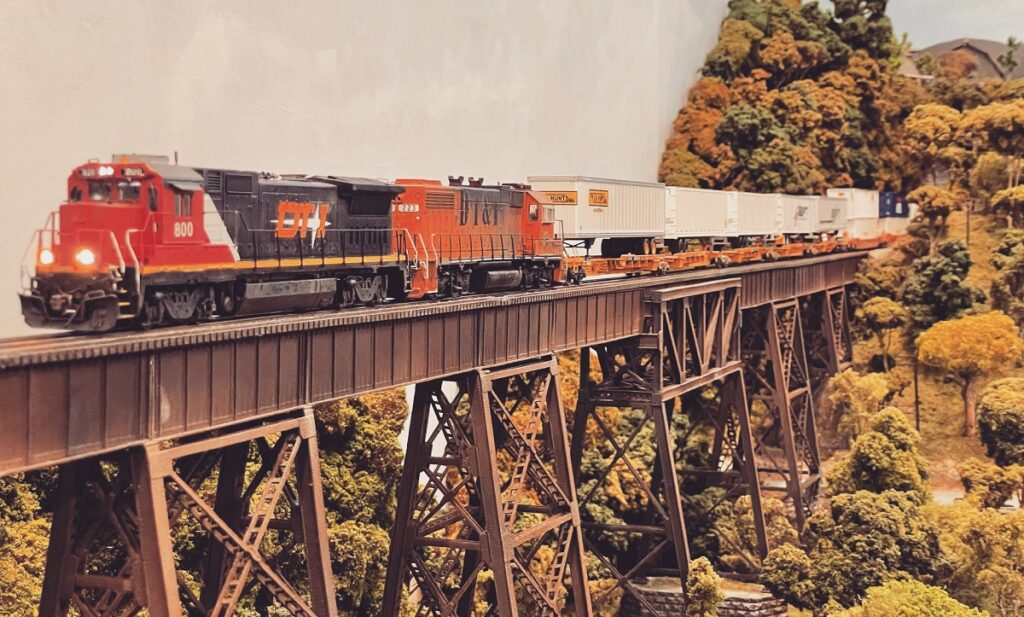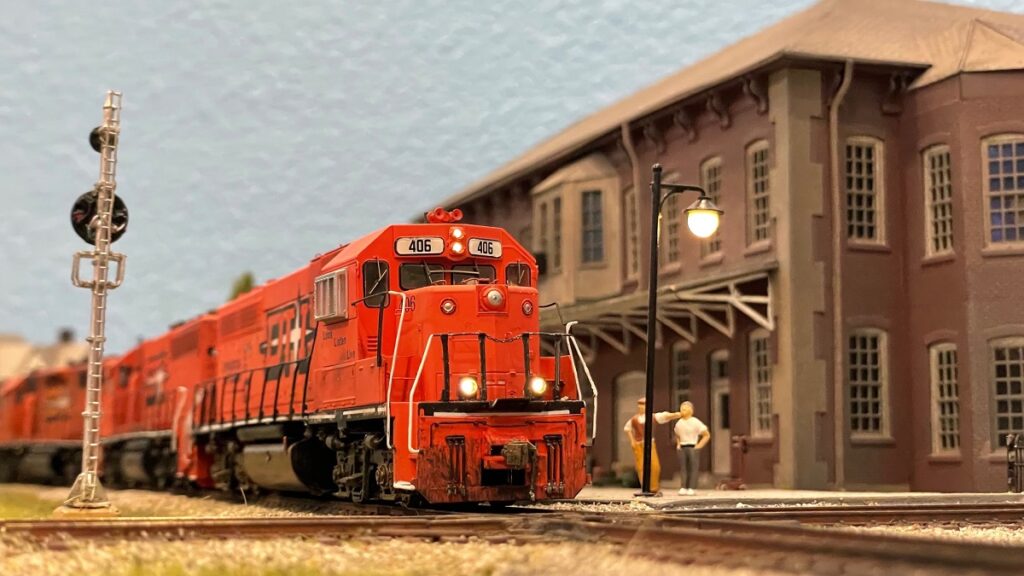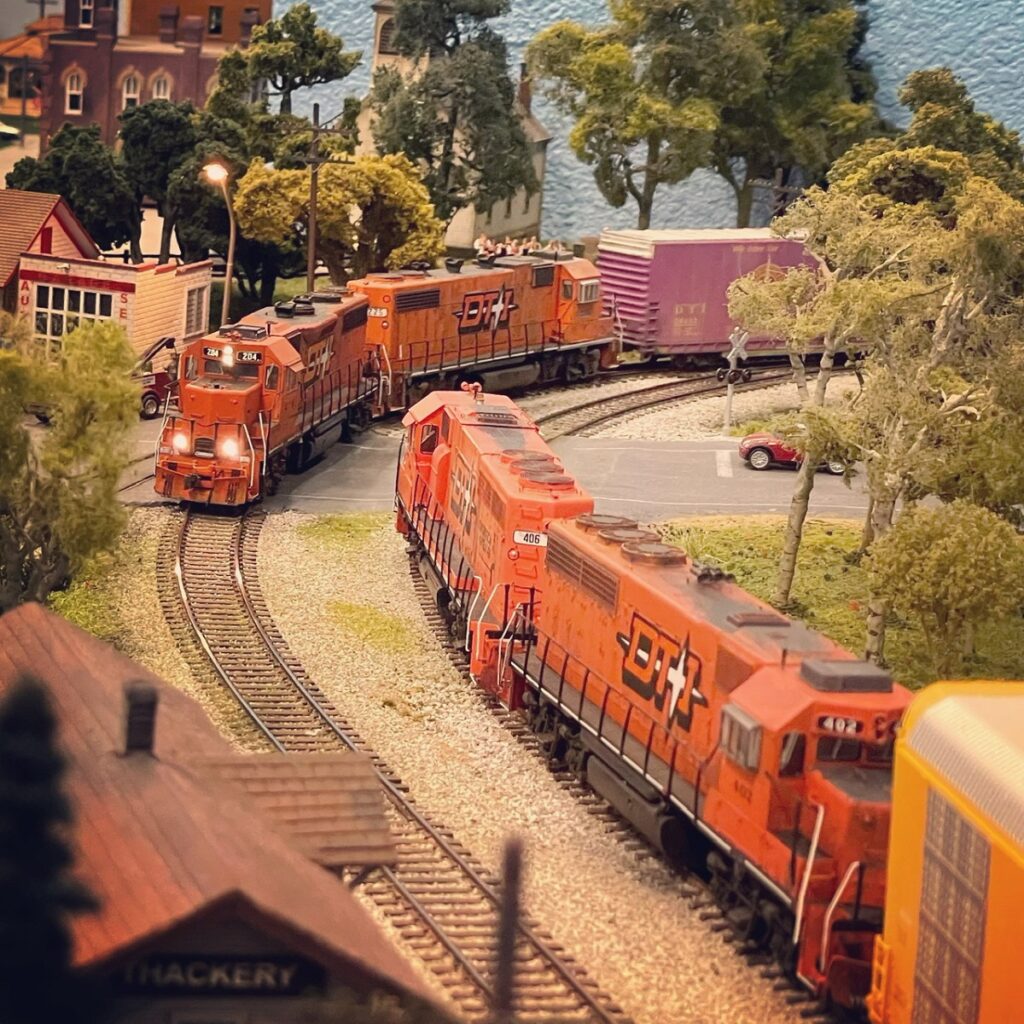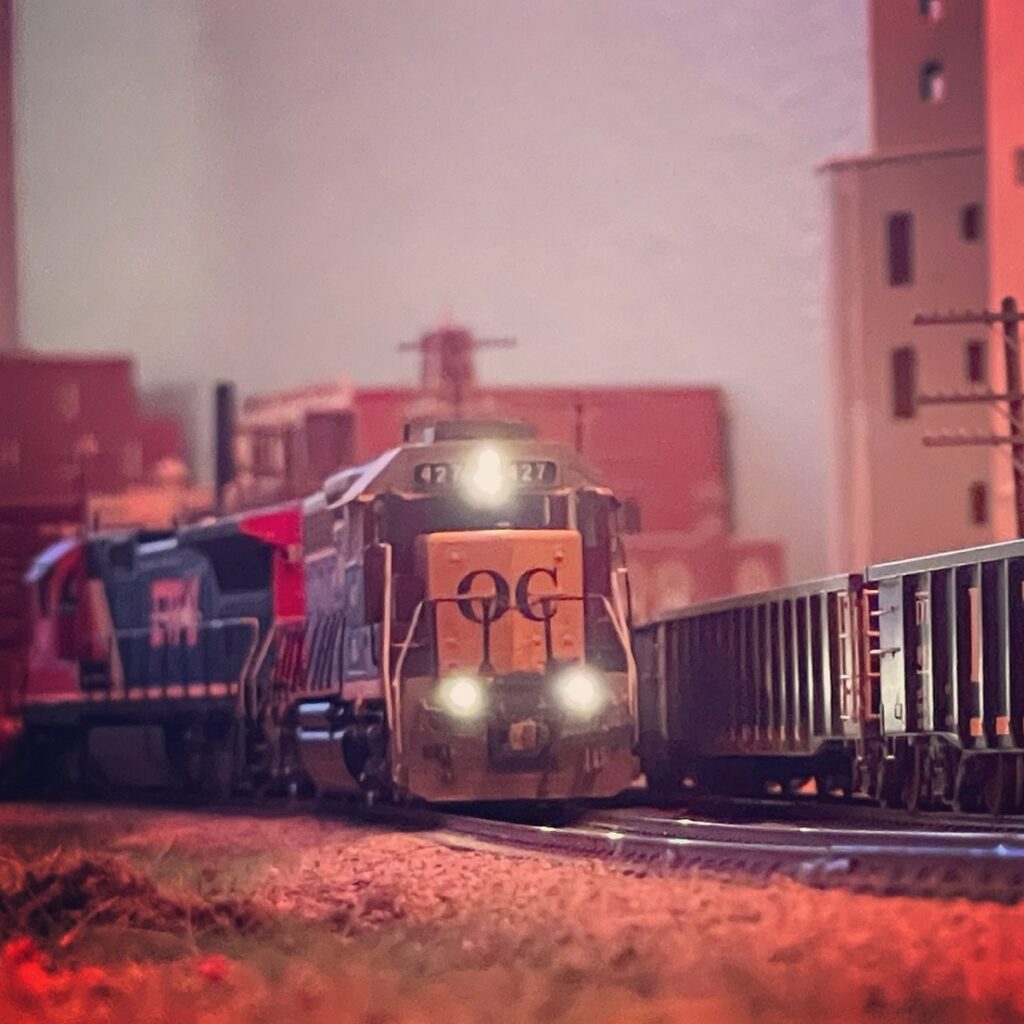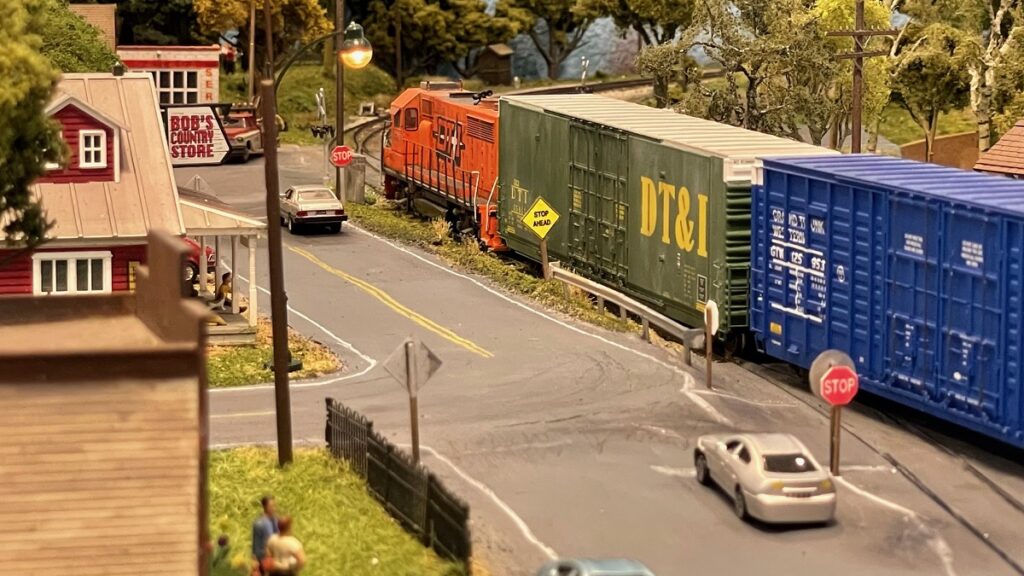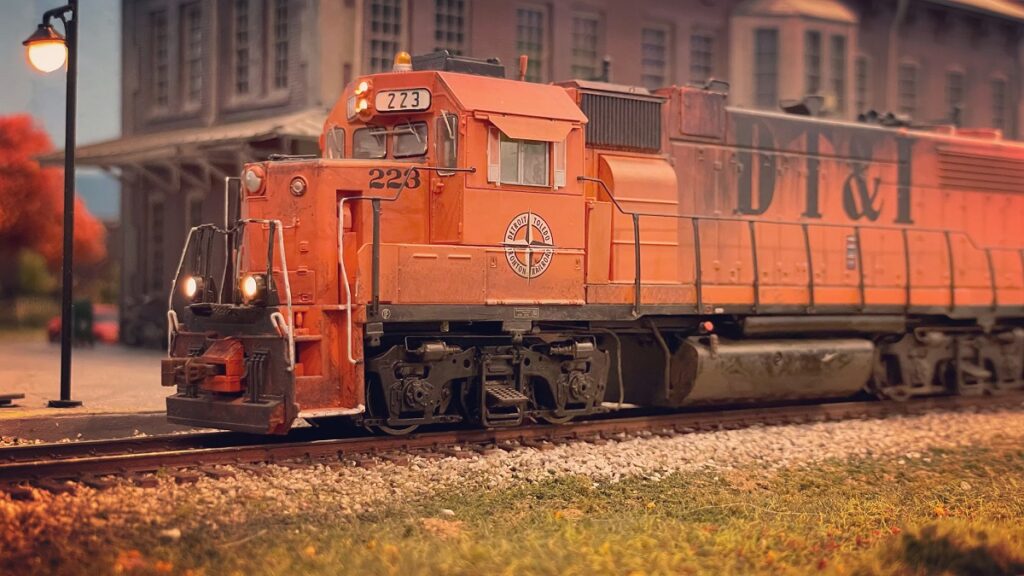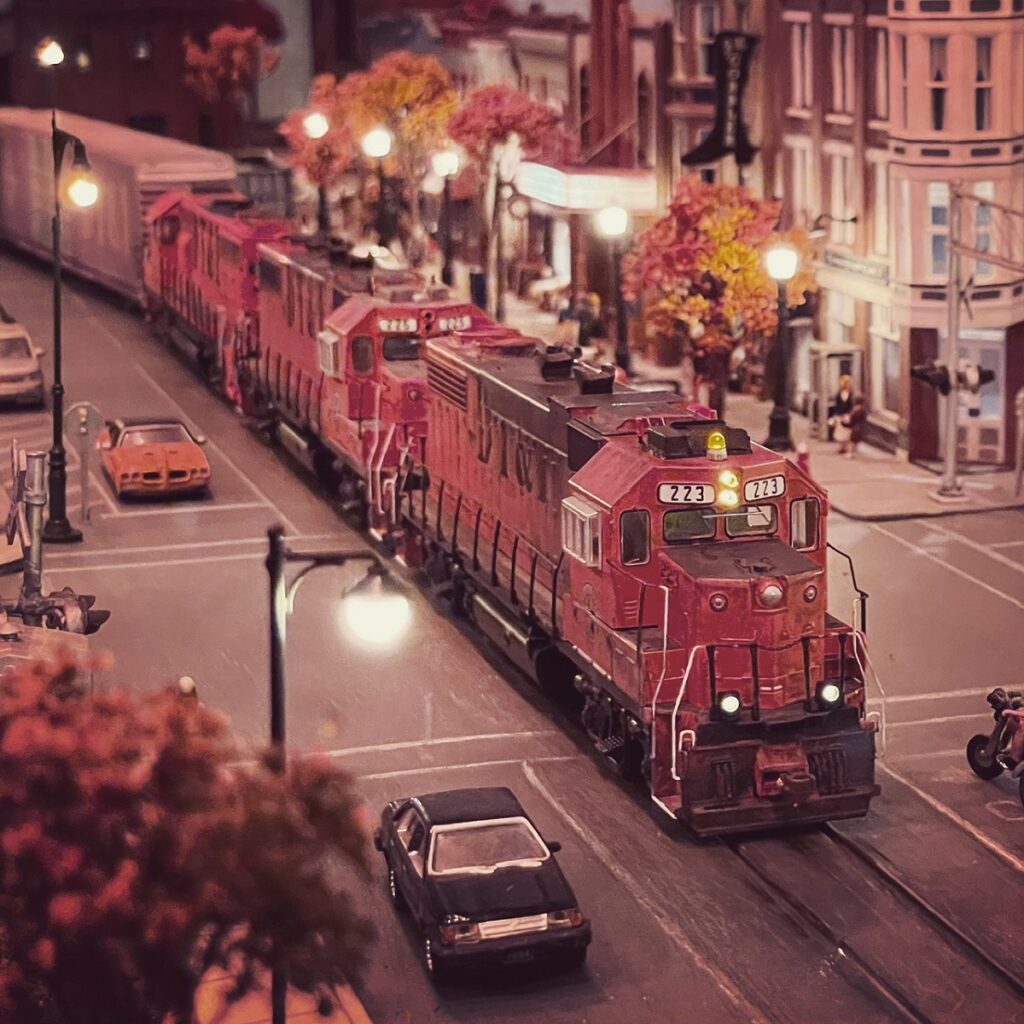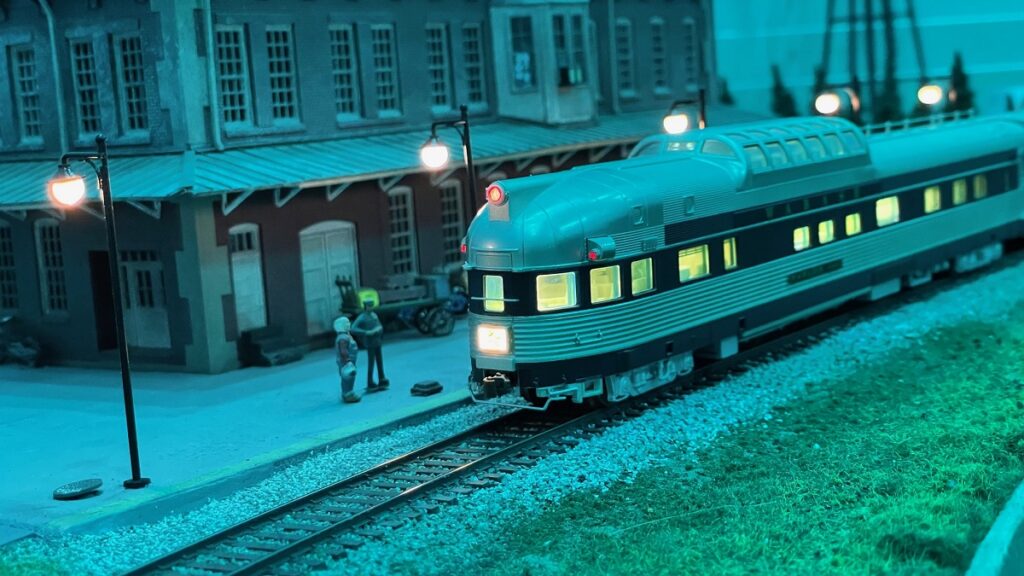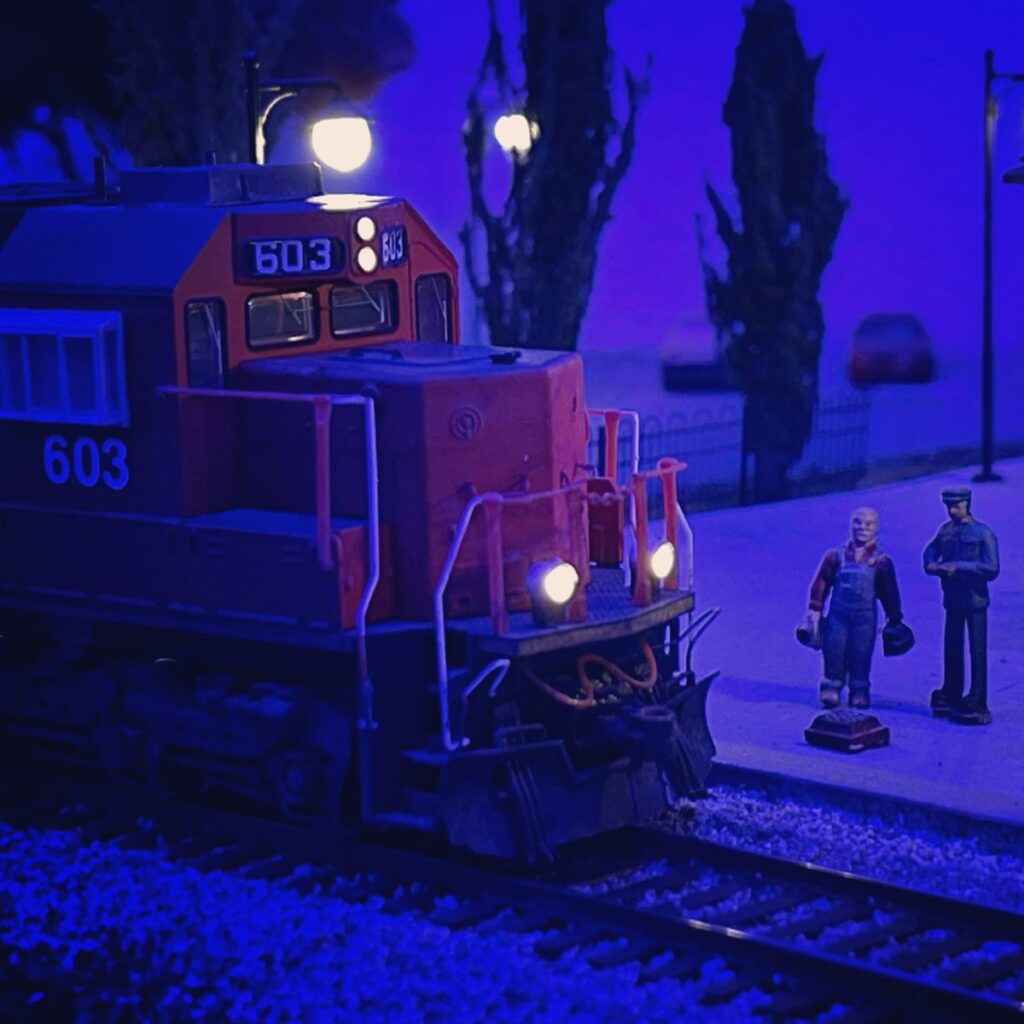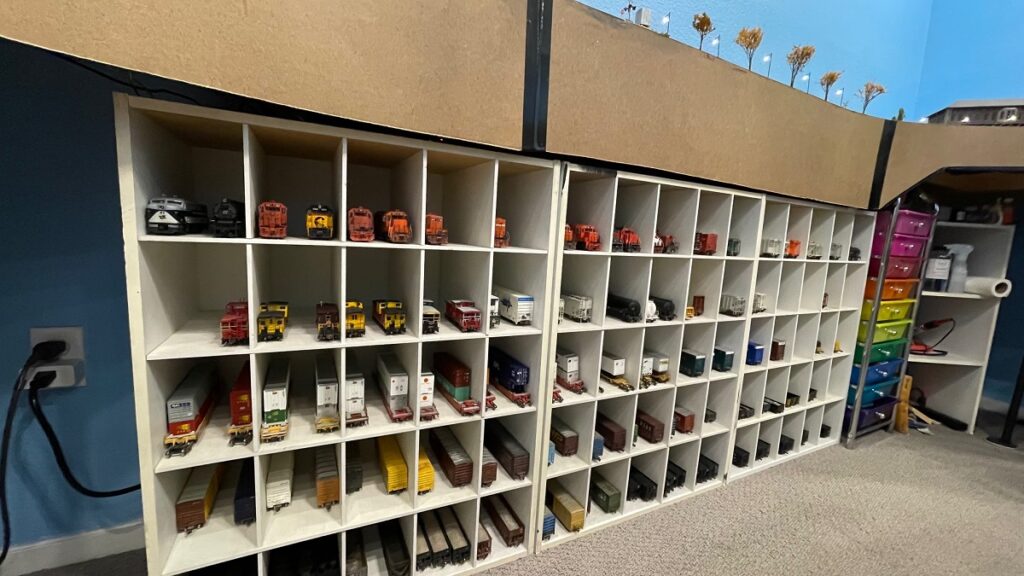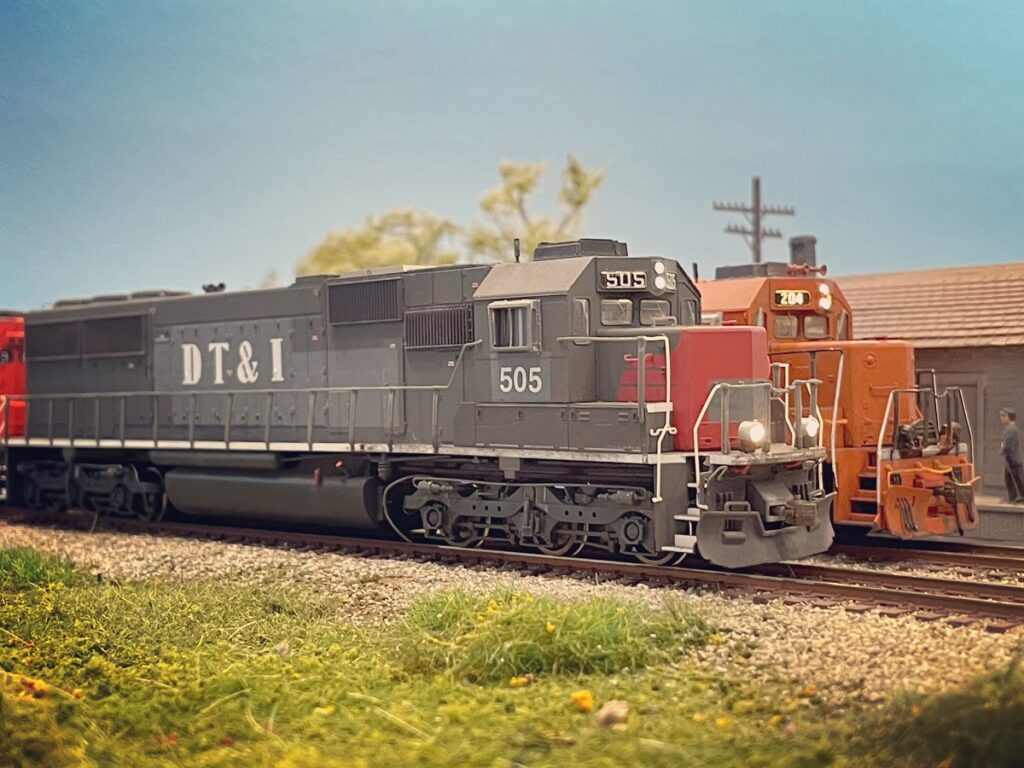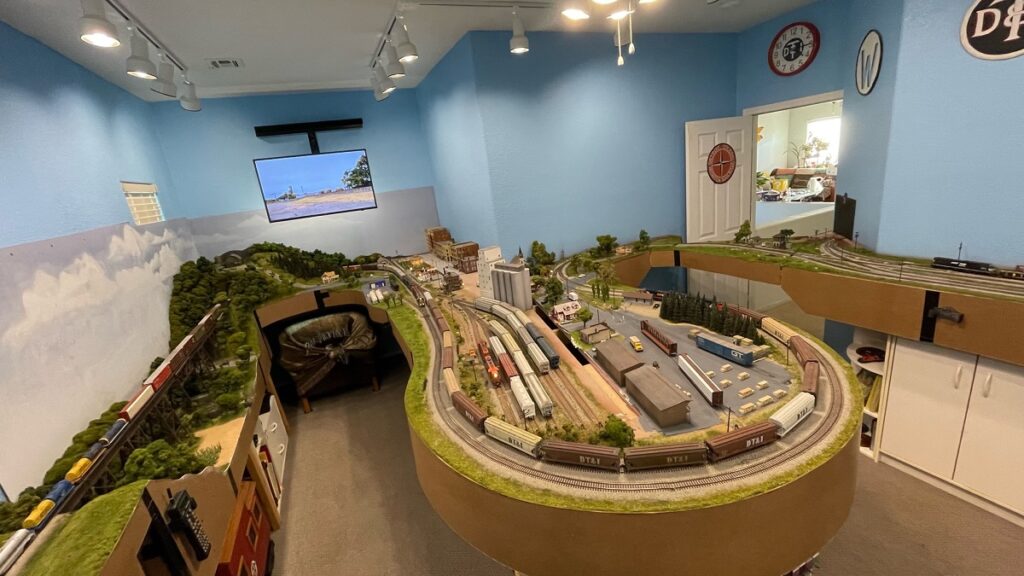Modern DT&I Railroad
- Layout name: The Modern DT&I
- Built by: Shaun Guzman-Thacker
- Type: Tabletop layout
- Dimensions: 19 x 15 ft (579 x 457 cm)
- Scale: HO
- Country: United States
- Epoch: Modern
- Rolling stock: Atlas, Walthers, Athearn, Broadway Limited, Rapido
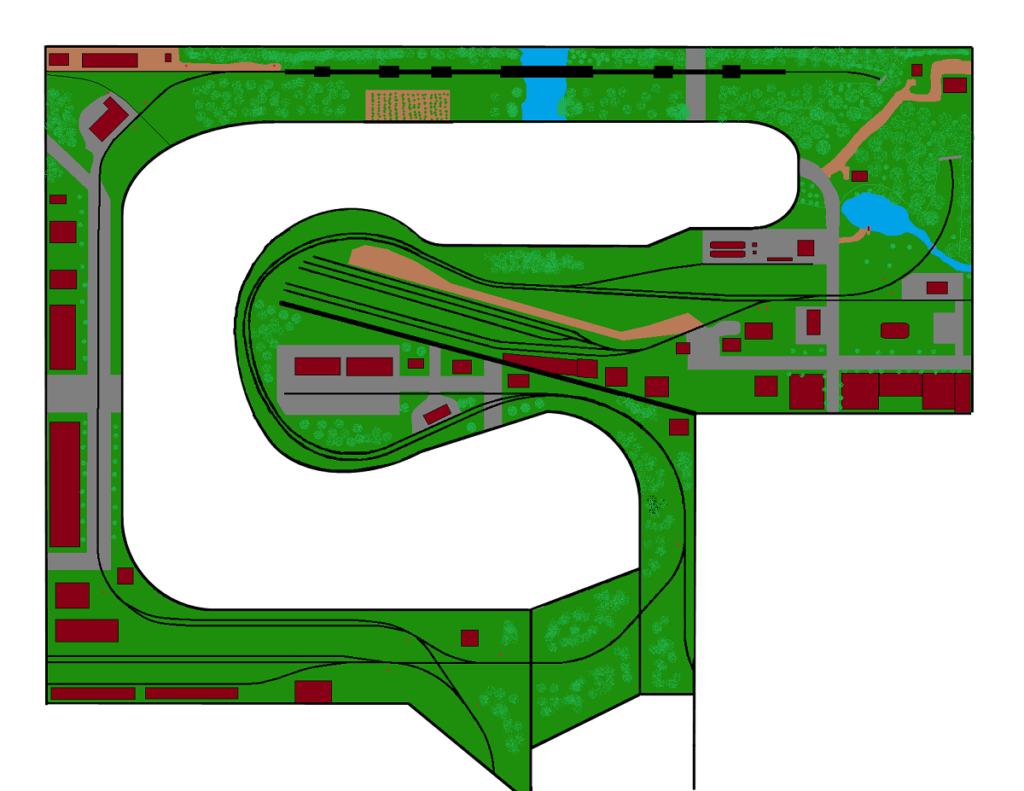
Hi! Tell us about yourself and how you got into model trains
My name is Shaun Guzman-Thacker. I’m 41, currently living in Las Vegas, NV. I’m originally from southeast Ohio, which is where most inspiration for my layout comes from. I’m married, and my husband’s father also does model trains. We have no children.
Besides trains, I love animals and plants. We have 3 cats, a saltwater aquarium, a freshwater aquarium, a banded gecko, and over 50 different kinds of houseplants. I’m also an avid flower gardener, and have plans to eventually build a garden railroad.
I’m a life-long Railfan. Both of my grandfathers fed my interest with many walks, adventures, and lots of research. I had my first HO scale layout around 10 years old. However, it wasn’t until my later teen years that I began an interest in the Detroit, Toledo, and Ironton railroad (DT&I) which is what I currently model. The railroad was once owned by Henry Ford, and has quite a fabled history. This history, along with recreating scenes as I remember them, are my favorite parts of the hobby.
I currently do not belong to any club or organization. Vegas doesn’t exactly have a large Railfan community. However, I keep myself active with others via instagram, Facebook, YouTube, and TikTok. If you’re interested in following, just search for the hashtag #moderndti.
Please describe your layout
My layout is a medium bedroom-sized layout in HO scale. It is approximately 19×15 feet in the main room, with 2 extensions into our game room planned. The layout is built with standard benchwork, with 2 inch foam board on top.
The terrain is a combination of carved foam and plaster cloth. The track is Peco code 83, with a minimum radius of 26 inches on the main and 22 inches in sidings. Turnouts are a mix of Atlas, Peco, and Walthers, with the smallest being number 5s. The layout is run by the NCE DCC 5 amp system, and is networked to allow Wi-Fi throttles as well.
The concept of the layout is based in freelanced into a more modern era. Basically the DT&I continues to exist today in my world. If you’re interested in an in depth look at the concept, please check out The Modern DT&I on Facebook. The layout is set between Ohio and Michigan, with the 7 foot long Quincy trestle being the main highlight.
Plans call for full signaled operations, and I love adding all the lights and such to buildings for night operations. In fact, the overhead lighting features smart bulbs from LIFX, which allow me to set the time of day, weather, and even animate to simulate rain and clouds. The backdrop is a mix of hand painting and photos.
This is actually the third iteration of the railroad. It started on a 6 by 14 tabletop, then moved to a modular, around the room design, before finally landing on its current, more permanent version. I’ve been lucky to have friends who are much better at carpentry and electronics help me design and build this, and if you go back through old versions of the layout online, you can really see how it has improved.
This version has existed for about 3 years, though almost everything on it has come from previous layouts. It is currently about 2/3 complete in the main room, and the extensions will be a separate phase to be planned later. Once those are operational, I plan on hosting a few operating sessions with close friends to nail down how to run it realistically. Once that is figured out, I hope to host public sessions.
I don’t build much myself by way of structures. I do kitbash on occasion, but you’ll find that most of the buildings on the layout are stock. I’m of the opinion if it looks good, why change it? I’m not too picky on that end. However, when it comes to locomotives, the more detail and functionality the better!
I do all my DCC and Lighting myself, and hope to begin painting them myself as well in the not too distant future. I like all lighting and signaling to function, and the layout is almost to the point where I can begin adding those components. I also do all of my own scenery, and many of the trees are hand crafted by me.
Living here does have its limits on model railroading. Most people I know here do N scale, because you can’t have basements here due to the sandy soil. So, we’re limited to our extra rooms. If I’m being honest, that is the whole reason I bought this house… otherwise it is way too big for the two of us! Ideally this would be a double deck layout in a basement, but I’m happy to have accomplished what I have with this space. I tried N scale myself, but the lack of detail and my eyesight just didn’t let that work for me.
How did you plan your layout?
I get asked this a lot. Believe it or not, I didn’t use any sort of planning software. Instead, I laid everything out in the room with Bachmann EZ Track. If you’re visual like me, I highly recommend this. Not only did it let me see how the trains would run, but let me place buildings, plan switching, and plan specific scenes.
Once that was done, a friend came over, measured everything, and planned the benchwork. We had most of it done in 2 weekends, and I had trains running not long after. One big thing we planned around was the Quincy trestle. I had already built that as a module so we simply planned the rest of the structure around it.
If I had it to do over, I would reconsider the extensions I have planned. Part of one side is actually going to be suspended above our entryway (the layout is upstairs), and I think the thought of that limited my planning initially. If I had considered that space from the start, I likely could have used broader curves and eliminated several curved turnouts, which can be problematic.
Describe your rolling stock
My locomotives are a mix of Atlas, Walthers, and Athearn. Athearn always nails it with the details, but when it comes to reliability, you just can’t beat Atlas or Walthers. I’m fine adding my own details to these.
Rolling stock is mostly automotive-related, such as auto racks, 86 foot parts cars, high cube boxcars, and the like. I have a pretty healthy mix of other freight, including a custom coal train. I base most of this on the current Indiana and Ohio, and Chicago, Ft. Wayne, and Eastern trains, which are the real life operators of the lines I model.
The railroad concept also owns a few scenic railroads, and I model them in the form of an Ann Arbor/Wabash dinner train, pulled by classic preserved diesels or steam. Here’s where I deviate from my brand loyalty a bit, as Broadway Limited makes the best steam locomotives and passenger cars in my opinion. The 317 is the only steamer I currently have, and the Wabash cars are also by BLI. The Ann Arbor FA-2 is by Rapido.
I weather all locomotives and rolling stock myself. I mainly use testers weathering pens, chalks, and makeup brushes for this. I upgrade the DCC, LEDs, ditch lights, and sound if needed. I’m going to eventually add truck lights as you’d see on the newest models out there, though that is going to challenge my soldering skills I’m sure.
I prefer NCE decoders for non sound, and Tsunami 2 for sound. Loksound is okay, but can occasionally be challenging to find help for in English. You also need their special programmer interface to change anything, so I just steer clear of them if I can. As mentioned, the layout is controlled by the NCE ProCab 5 amp system. It is networked so Wi-Fi throttles can also be utilized.
Advice for other people in the model train world
When I started in the hobby, I didn’t know anyone outside of my grandfathers who liked model trains. I would occasionally get a magazine at the grocery store or books from the library to study. These days you have an infinite amount of resources with social media. Use them! I’m in several groups myself and am constantly inspired by what I see there.
Don’t be afraid to mess up, especially on scenery. If you dissect my scenery you’ll find layers and layers. I just add til I’m happy with the look of it. Also, don’t be afraid to use natural materials. Sift some dirt from your backyard. Blend up dried leaves. Dry plants to make tree bases. The hobby is expensive no doubt but there we definitely things you can try to mitigate costs. I would caution you not to do this with your control/power supply and your locomotives though. You definitely get what you pay for.
Start small. There are a ton of starter kits for 4 by 8 layouts out there. As you practice your skills, you will start to see where you can or want to expand…or you may be perfectly happy with that size. Personally I like a medium sized layout to be able to run 20ish car trains but still be able to actually finish it. My first real layout was an EZ track kit, which I painted and ballasted. It looked just as good as professionally laid track in my opinion!
Another great piece of advice I’ve learned is not to fuss over those really expensive cars and locomotives. I’ll use the SD60 as an example. Athearn’s version is top of the line in detail and features, but can run you $300 or more, and they’re fairly fragile. On the other hand, the Walthers version is much more sturdy and they offer the detail kits separately, should you want to add them later. Starting out, I’d go for something like this versus top of the line.
Not only will it save you money but likely frustrations over broken parts as well. The same goes for freight cars. Get yourself 3 or 4 really nice ones to put at the front and end of the trains and fill the rest of it up with cheaper ones. You’ll never notice. As you advance in the hobby, most products these days are fully upgradable, and you can add as you see fit.
All in all, the best advice I could give anyone starting out in the hobby is to have fun. Lots of modelers out there are super serious about their hobby, and to me, that just takes the joy out of it. Model trains are my peace, as any hobby should be.
Don’t judge others based on their skill level. Lift them up and support them. There are plenty of people out there that won’t, and it’s a shame. If you’re having fun, that is all that matters. After all, this is the worlds greatest hobby!


